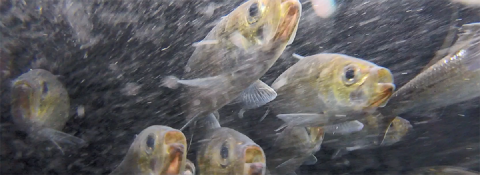What We Do
Since 2005, the Maine Fish and Wildlife Conservation Office has assisted State partners in completing 196 aquatic connectivity projects. These projects restored fish passage fish passage
Fish passage is the ability of fish or other aquatic species to move freely throughout their life to find food, reproduce, and complete their natural migration cycles. Millions of barriers to fish passage across the country are fragmenting habitat and leading to species declines. The U.S. Fish and Wildlife Service's National Fish Passage Program is working to reconnect watersheds to benefit both wildlife and people.
Learn more about fish passage and ecological function to more than 650 miles of stream habitat. We removed barriers and replaced them with structures, such as bridges or open-arch culverts that span at least 1.2 times the bank-full width of the natural stream. Nearly all of these restoration efforts have been conducted within designated critical habitat for endangered Atlantic salmon.
Our Organization
Our Species
Each spring, hundreds of thousands of fish migrate from the ocean to the rivers in Maine: alewife and blueback herring, American eel, American shad, Atlantic salmon, Atlantic sturgeon, and striped bass. These fish are ecologically, culturally and economically important to the region as an important food source for people, and for other fish and wildlife, including fish and wildlife that people like to eat. Indeed, restoring these important migratory fishes and resident fish, like the eastern brook trout, are priorities for us. We are removing obstacles to migration, and creating fishways so fish can migrate around dams.
Projects and Research
The China Lake Outlet Stream Restoration Project will restore connectivity through the entire Outlet Stream in central Maine, opening fish passage from China Lake's incredible 3,939 acres of alewife spawning and nursery habitat to the mainstem Sebasticook and Kennebec Rivers, which flow into the Atlantic Ocean. Formerly, six barriers prevented fish passage along the stream.
...
The project to remove two dams—the Upper Town Dam and the Remnant Mill Dam—from the Sabattus River, a tributary to the Androscoggin River in Maine, has been successfully completed. Both dams were removed, accompanied by bank restoration, stabilization, and revegetation efforts.
These removals have eliminated public safety hazards, reduced flooding risk, and restored parks, providing safe...
Across the landscape, undersized, aging and improperly placed road-stream crossings create barriers in our rivers, streams, and tidal wetlands. These structures fragment aquatic habitat and prevent or greatly reduce the ability of aquatic species to move freely to migrate, feed, and reproduce. These poorly designed structures are also more prone to clogging, causing flooding, and washing out...
Get Involved
Whether you want to further conservation, learn more about nature or share your love of the outdoors, you’ve come to the right place. The Maine FWCO provides many opportunities for you to help your community and fish and wildlife by doing what you love.
We partner with volunteers, youth groups, landowners, neighbors and residents of both urban and rural communities to make a lasting difference. There are opportunities for everyone to get involved!
Volunteers: Gain new experiences and meet new people while helping to advance fish and aquatic conservation.
Friends: Join neighbors in helping hatcheries work effectively in our communities.
Local Groups: Find out how communities can work with hatcheries to conserve our shared natural resources.
Youth: Explore paid and unpaid opportunities to learn and develop leadership skills.
Location and Contact Information
- Maine Fish and Wildlife Conservation OfficeView Details306 Hatchery Road East Orland, ME 04431-5000




























